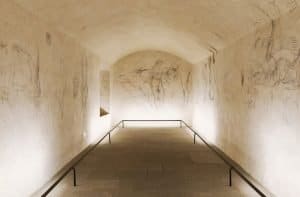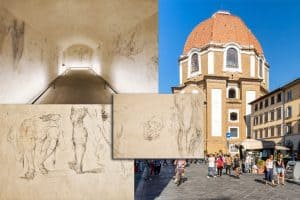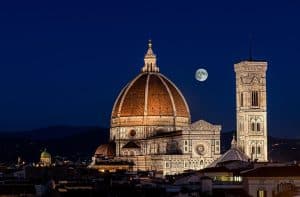Guide To The Pitti Palace (Palazzo Pitti) – Florence, Italy
Pitti Palace (Palazzo Pitti) and Its Museums: What to See
Pitti Palace (Palazzo Pitti) is mainly known for having been the residence of the Medici family. Today, it houses important Florentine museums, not to mention its marvelous Boboli Gardens. Let’s delve into its history and explore what a visit to this Renaissance palace has in store.
History of Pitti Palace (Palazzo Pitti)
Pitti Palace (Palazzo Pitti) is located in the Oltrarno district of Florence. It is easily reachable from the historic center by crossing the Ponte Vecchio, and after a short straight stretch, one finds oneself on Piazza Pitti.
The banker Luca Pitti, a fierce enemy of the Medici family, desired its construction primarily to showcase his economic prosperity and prestige.
However, this ambition led him to bankruptcy. In 1549, Cosimo I de’ Medici purchased Palazzo Pitti for his wife, Eleonora di Toledo, the daughter of the Viceroy of Naples. The Grand Duchess suffered from health problems and needed to live in a healthier and sunnier environment, away from the city’s chaos.
In a short period, many other nobles and wealthy bourgeoisie followed their example, and the Oltrarno district became an exclusive residential area.

The architecture of the original Palazzo Pitti was the work of Luca Fancelli, a student of Brunelleschi. Over the centuries, it was renovated and expanded by Bartolomeo Ammannati, Nicolò Tribolo, Vasari, and Bernardo Buontalenti. They were also responsible for the vast Boboli Gardens located behind Pitti Palace (Palazzo Pitti).
After the Medici, Pitti Palace (Palazzo Pitti) was inhabited by the Habsburg-Lorraine family, briefly by Napoleon, and finally by the House of Savoy, with Vittorio Emanuele II. In this case, it became a royal palace since Florence served as the capital of Italy between 1865 and 1871.
This grand palace currently houses five museums and temporary exhibitions, and since 1952, it has also been the venue for luxurious and renowned fashion shows.
Architecture of Pitti Palace (Palazzo Pitti) in Florence
Originally, Palazzo Pitti was much smaller, and its facade had three levels. On the ground floor, there were three portals, of which only the central one remains. On each of the upper two floors, there were seven windows.
The Rusticated Stonework of Pitti Palace (Palazzo Pitti)
Pitti Palace (Palazzo Pitti) is also distinguished by its striking and heavy rusticated stonework, which was common in other Renaissance palaces in Florence. These are large blocks of rough stone with straight and finished edges, likely to channel rainwater and prevent it from entering the interior. This type of cladding also made the palaces more majestic and robust.
In the case of Pitti Palace (Palazzo Pitti), the blocks on the lower level are more rustic and massive, gradually becoming more elegant and smooth as they ascend.
Looking at the facade towards the left, between the large windows on the ground floor, two blocks of contrasting sizes can be observed. Legend has it that Luca Pitti used these two stones to compare his immense wealth to what he considered the meager riches of his enemies. Thus, the reason for the proximity of a highly long stone and a concise one is explained.
NAUMACHIA AT Pitti Palace (Palazzo Pitti)

When the Medici family arrived, followed by the Habsburg-Lorraine family, the palace expanded with two lateral wings and a vast enclosed inner courtyard. The splendid scenography of this central court, designed by architect Ammannati, was used for spectacular celebrations and receptions. In 1589, a naumachia was organized for the lavish wedding of Ferdinando I de Medici and Christina of Lorraine, even filling the courtyard with water. They sought to simulate a naval battle with 18 Turkish and Christian ships of different shapes and sizes.
The courtyard is closed on the fourth side, facing the entrance gate by the Moses Fountain, which serves as an introduction to the magnificent Boboli Gardens.
On the other hand, the monumental staircase leads to the raised floors, which house important museums and public events.
VASARI CORRIDOR

Pitti Palace (Palazzo Pitti) is connected to Palazzo Vecchio through the famous Vasari Corridor. It was created by Giorgio Vasari and commissioned by Cosimo I de Medici in 1565. It served as a secure secret passage for the dukes, allowing them to move from their residential palace to the seat of power in Florence, Palazzo Vecchio.
The construction took five months, and the corridor extended through the Ponte Vecchio and the Uffizi Gallery. It is now possible to walk through it by participating in special guided tours, which allow visitors to see portraits and ancient Roman and Greek sculptures.
The Vasari Corridor connects the Boboli Gardens to the Buontalenti Grotto and is nearly one kilometer long. From its 73 small windows, one can admire specific views of Florence.
Read More About Vasari Corridor
VISITING THE MUSEUMS OF Pitti Palace (Palazzo Pitti)
The visit to Palazzo Pitti begins at the central entrance gate facing Piazza Pitti. Once inside, you find yourself in the courtyard of Palazzo Pitti. Ascending the monumental staircase, you reach the main floor, which houses the Palatine Gallery and the Royal Apartments.
Only some of the museums of Palazzo Pitti are located within the main building. For example, the Museum of Porcelain is situated in the Cavaliere Building, in an elevated part of the Boboli Gardens.
PALATINE GALLERY – Pitti Palace (Palazzo Pitti)
The Palatine Gallery, on the first floor of Palazzo Pitti, is a treasure trove of artistic masterpieces created over four centuries. The museum originated in the late 18th century when the Habsburg-Lorraine family exhibited their rich collections of paintings and sculptures, mostly inherited from the Medici family.
The walls of the sumptuous rooms, adorned with frescoed and decorated ceilings, are practically covered with paintings by renowned artists such as Raphael, Filippo Lippi, Tintoretto, Caravaggio, and Rubens.
The visit to the Gallery begins in the Hall of the Grooms and continues through the Greek and Roman statues Gallery. Then, you reach the Duke’s Apartments and the Duchess’s Apartments. The latter is also known as the “Quartiere del Volterrano,” named after the painter Baldassarre Franceschini.
In the Hall of Allegories, he depicted the virtues of Grand Duchess Vittoria della Rovere, wife of Ferdinando II de Medici. Thanks to her many works by Raphael, Titian, and numerous other artists arrived in Florence.
The rooms of the Grand Duke‘s Apartments bear the names of mythological characters, such as Hercules, Ulysses, Apollo, and the Planets. The Jupiter Room was the throne room, while the Grand Duchy‘s Council used the Prometheus Room.
GUIDE TO THE PITTI PALACE (PALAZZO PITTI) – FLORENCE, ITALY
ROYAL APARTMENTS – Pitti Palace (Palazzo Pitti)
On the same floor of Palazzo Pitti, you will also find the Royal Apartments, which the Savoy family used. They are responsible for the Empire-style decorations of the rooms, which display sculptures, paintings, furniture, and collections of gilded bronzes and Chinese and Japanese vases.
MODERN ART GALLERY – Pitti Palace (Palazzo Pitti)

The second floor houses the Modern Art Gallery, including artistic collections from the late 18th century to the early 20th century. The works belong to artistic movements such as Neoclassicism, Decadentism, Symbolism, Post-Impressionism, and the Macchiaioli school.
SILVER MUSEUM – Pitti Palace (Palazzo Pitti)
You will find the Silver Museum on the ground floor and the mezzanine, also known as the Treasure of the Grand Dukes. The beautifully frescoed rooms facing Piazza Pitti were the representation halls of the Grand Dukes of Florence, while the simpler ones at the back were their private apartments.
In these spaces, you can admire elaborate artistic objects made of crystal, precious gems, clocks, and tapestries created by Florentine artists and others from different parts of Italy and Europe.
FASHION AND COSTUME MUSEUM – Pitti Palace (Palazzo Pitti)
Adjacent to Palazzo Pitti, in the Palazzina della Meridiana, you will find the Fashion and Costume Museum. The building takes its name from the sundial of 1699, which was placed in the vestibule of Ferdinando dei Medici‘s apartment. The gnomonic hole, through which sunlight enters, is located in the vault frescoed with the allegory of Time.
The Fashion and Costume Museum dates back to 1983 and showcases clothing and fashion accessories from the late 16th century to the present. You can also admire garments worn by film actors and theater performers, signed by renowned international designers.
PORCELAIN MUSEUM – Pitti Palace (Palazzo Pitti)

The Palazzina del Cavaliere, on the Boboli Garden hill, is now the seat of the Porcelain Museum. Its three large rooms exhibit porcelain collections from the Medici, Lorena, and Savoy families, originating from Europe’s most important manufacturers, such as the Royal Factory of Naples, Sevres, Meissen, and Vienna.
Is Pitti Palace worth it?
The short answer is Yes. This is a bit walk, but the Pitti Palace is worth attending. Lots of stairs, so be ready; there were 3 or 4 double sets to go up (and down) to get to the apartments. The paintings are unique (be sure to look up at the ceilings, they are gorgeous), and many are genuinely stunning.
Which is better Uffizi or Pitti Palace?
The Uffizi Gallery is the best choice to see great works of paintings. The displays are at eye level, and there are no works placed high up on the wall as they are at Pitti Palace. Many of the paintings at the Palace are great.
Is the Pitti Palace free?
No. Regular – 16€ and Reduced – 2€. If you make a reservation online, you must pay an additional 3€ as a reservation fee.
What days are free at Pitti Palace?
The First Sunday of the month allows free entry to the Pitti Palace. Even though free, you must get a FREE ticket at the ticket office.
Is there a dress code for the Pitti Palace?
There is no particular dress code at Pitti Palace. We suggest you wear comfortable shoes, as moderate walking is here.




